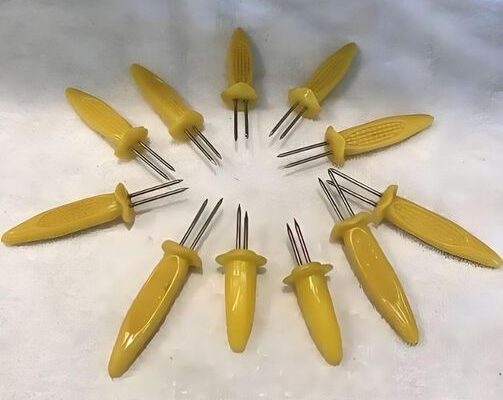Corn on the cob is a beloved summer treat enjoyed by people around the world. If you’ve ever enjoyed a hot, steaming cob of corn, you know just how helpful those little corn holders can be. They make it easy to enjoy the sweet kernels without burning your fingers or struggling to keep a firm grip. But have you ever wondered about the history of these simple but essential utensils? Corn on the cob holders, also known as corn skewers, have a rich history dating back to the early 19th century. Over time, their design and functionality have evolved, but they remain a staple in kitchens and outdoor gatherings. Let’s take a look at their origins, how they’ve changed, and why they continue to hold a special place at the table.
The Early Days: Corn Holders in the 19th Century
In the early 1800s, corn became a common food in many parts of the world, especially in North America. As corn on the cob grew in popularity, so did the need for an easier way to eat it. The early versions of corn holders were handcrafted from simple materials like wood or bone. These early designs had one main purpose: to provide a firm grip on the cob, keeping fingers clean and preventing burns.
Corn on the cob was often enjoyed outdoors, cooked over open flames at family gatherings or community events. But as anyone who’s ever eaten buttered corn can attest, the cob can get slippery. This prompted the invention of the corn skewer—a two-pronged tool that made handling hot corn a lot easier and more comfortable.
The Evolution of Corn Holder Designs
As time passed, corn holders began to evolve, not only to become more functional but also more stylish. Early versions were quite basic—just two pointed prongs made from wood or metal that were inserted into the ends of the cob. These simple designs were practical and served their purpose well.
By the mid-20th century, corn holders started to reflect advancements in kitchen tools. Manufacturers began experimenting with new materials and styles to improve comfort and durability. Corn holders were no longer just functional—they became decorative too. Handles made from materials like bakelite, stainless steel, and plastic grew in popularity. Ergonomic designs also emerged, offering better grip and comfort while eating.
Modern Corn Holders: Practical and Fun
These days, corn holders come in countless designs, ranging from simple prongs to more elaborate and ergonomic models. Many modern versions feature heat-resistant handles, making it easier to handle hot corn. There are even corn holders with fun, themed designs, such as handles shaped like corn kernels, animals, or other playful elements. These quirky designs add a fun touch to barbecues, family picnics, and other outdoor gatherings.
Other innovations include silicone grips for added comfort and eco-friendly options made from sustainable materials like bamboo. These changes reflect the evolving needs of modern kitchens and show how even the simplest tools can adapt to new trends.
Corn Holders and Cultural Significance
Corn on the cob holders are more than just practical utensils—they also hold cultural value. In areas where corn is a staple, these small tools represent family gatherings, summer cookouts, and shared meals. Corn has been a part of culinary traditions for centuries, and eating it straight off the cob is often linked with community and celebration.
During the 20th century, corn holders became a symbol of American summer cookouts. Families and friends would gather around outdoor grills and picnic tables to enjoy grilled corn, burgers, and hot dogs. In some families, vintage corn holders are passed down through generations, becoming cherished keepsakes that carry a nostalgic reminder of summers past.
The Craftsmanship of Vintage Corn Holders
Vintage corn holders from the mid-1900s are admired not only for their functionality but also for their craftsmanship. Many of these older pieces were built to last, featuring sturdy metal prongs and durable handles made from materials like bakelite or early plastics. These vintage holders are now often sought after by collectors, who appreciate their charm and historical significance.
Corn Holders Today: Still Going Strong
Despite the advancements in kitchen tools, corn on the cob holders remain as popular as ever. Their simple yet effective design continues to make them a practical choice for enjoying corn without the mess. Whether at home, at a barbecue, or during outdoor gatherings, corn holders allow everyone to savor their corn without worrying about burnt fingers or sticky hands.
Today’s corn holders are designed with convenience in mind. Many sets come with handy storage cases, making it easier to keep track of them when they’re not in use. Dishwasher-safe materials also make cleanup a breeze, ensuring they’re always ready for the next family barbecue.
Conclusion: The Legacy of Corn on the Cob Holders
From their humble beginnings as simple wooden skewers to today’s heat-resistant, decorative designs, corn on the cob holders have come a long way. These small tools have brought convenience to countless meals and continue to be a staple at summer cookouts and family gatherings. Their enduring appeal lies in their simplicity, practicality, and the nostalgia they bring. As long as people enjoy corn on the cob, there will always be a place for these timeless tools. So the next time you enjoy a cob of corn, remember the legacy of the little holders that make it all the more enjoyable.
